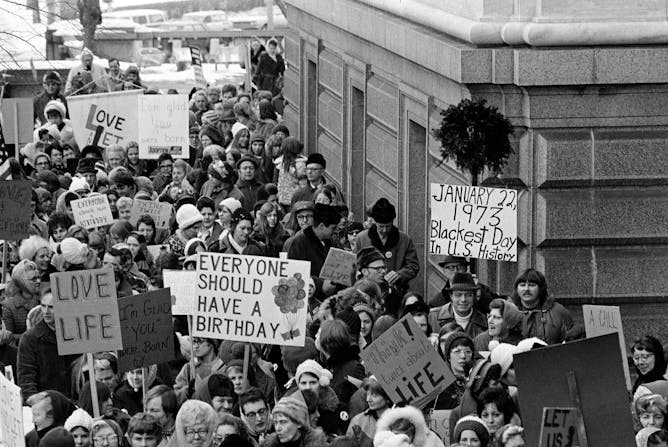|
|
|
|
Medical realities for women have changed since the U.S. Supreme Court’s decision to overturn the constitutional right to an abortion afforded nearly 50 years ago by the Roe v. Wade decision.
That’s especially true for Black and brown women.
In her sober analysis, San Diego State University professor Kimala Price writes about the problems getting reproductive health care in what are known as contraceptive deserts, where many Black and brown women live and where the needs outstrip the available range of care.
Though the rates of abortion have generally declined since the 1980s, the rate of abortions by Black and brown women remains much higher than for white women. Those higher rates, Price writes, are due to higher rates of unintended pregnancies, which themselves health care professionals attribute to limited access to the full range of services. And for many of these women, traveling to a state where abortions remain available is not always an option.
“Women of color,” Price concludes, “will see further erosion of their right to make the fundamental decisions about the most intimate aspects of their lives.”
|

|
Howard Manly
Race + Equity Editor
|
|

An abortion rights activists is detained on June 30, 2022, during a rally near the U.S. Supreme Court in Washington, D.C.
Nicholas Kamm/AFP via Getty Images)
Kimala Price, San Diego State University
By overturning Roe v. Wade, the US Supreme Court has thrown the issue of abortion back to the states – and made it harder for Black and brown women to have access to reproductive health services.
|

President Joe Biden with first lady Jill Biden, speaking before signing into law the gun safety bill on June 25, 2022.
AP Photo/Pablo Martinez Monsivais
Monika L. McDermott, Fordham University; David R. Jones, Baruch College, CUNY
Two scholars of Congress and public opinion dissect the reasons gun control finally passed and was signed into law, after decades of inability to enact such legislation.
|

A 1973 photo shows an estimated 5,000 people, women and men, marching around the Minnesota Capitol building protesting the U.S. Supreme Court’s Roe v. Wade decision.
AP Photo
Daniel K. Williams, University of West Georgia
A historian explains why the pre-Roe anti-abortion movement was filled with liberal Democrats who opposed the Vietnam War and supported the expansion of the welfare state.
|
|
|
-
Maurizio Valsania, Università di Torino
A scholar of 18th-century America and the founders analyzes the Supreme Court opinion overturning the constitutional right to abortion, which he says relies on an incomplete version of US history.
-
A.D. Carson, University of Virginia
Since rap music emerged in mainstream culture in the late 1980s, politicians have derided its lyrics and imagery as violent. Over the years, rap has become an easy target to blame for violence.
-
Donovan Schaefer, University of Pennsylvania
Overcoming conspiracy theories isn’t just about information. A scholar of religion explains that the emotions they inspire are part of their appeal.
-
Cynthia Golembeski, The New School; Matthew Bakko, University of Michigan
The median amount of cash bail is $10,000 – an immense sum for people living in poverty. Bail funds, unlike bail bondsmen, don’t charge high fees.
-
Barbara A. Trish, Grinnell College
The Iowa caucuses have traditionally heralded the start of the Democratic Party’s presidential nominating contest. But the party, eager to maintain the White House, is redesigning that process.
-
Patrick Parenteau, Vermont Law School
In a 6-3 ruling, the Supreme Court held that an Obama administration plan to regulate carbon emissions from power plants exceeded the power that Congress gave to the Environmental Protection Agency.
-
Jonathan Entin, Case Western Reserve University
When Rosa Parks was arrested for sitting in the front of a bus in Montgomery, Fred Gray was her lawyer. Now he’s being honored for a lifetime of civil rights advocacy.
-
Lily Hsueh, Arizona State University
A review of S&P 500 companies finds carbon disclosure doesn’t necessarily mean emissions fall.
-
Stella Rouse, University of Maryland; Shibley Telhami, University of Maryland
Researchers found political partisanship is a significant factor in determining perceptions of discrimination against different racial groups.
|
|
|
Like this newsletter? You might be interested in our other weekly emails:
|
| |
| |
| |
| |
|
|
|
|
|
|
|